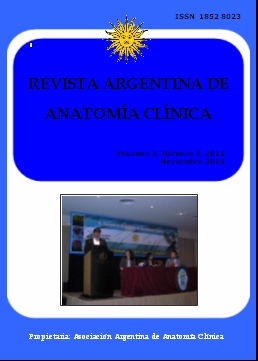PERFORATION OF INFERIOR ALVEOLAR NERVE BY MAXILLARY ARTERY. Perforation of inferior alveolar nerve by maxillary artery
DOI:
https://doi.org/10.31051/1852.8023.v3.n3.13935Keywords:
Infratemporal fossa, Inferior alveolar nerve, Variation, Applied anatomy, Fosa Infratemporal, nervio alveolar Inferior, variación, anatomía aplicadaAbstract
La fosa infratemporal es un área anatómica clínicamente importante para la administración de agentes anestésicos locales en odontología y cirugía maxilofacial. Fueron estudiadas variaciones en la anatomía del nervio alveolar inferior y la arteria maxilar en la disección infratemporal. Durante la disección rutinaria de la cabeza en el cadáver de un varón adulto, fue observada una variación excepcional en el origen del nervio alveolar inferior y su relación con las estructuras circundantes. El nervio alveolar inferior se originaba en el nervio mandibular por dos raíces y la primera parte de la arteria maxilar estaba incorporada entre ambas. El origen embriológico de esta variación y sus implicaciones clínicas es debatido. Dado que la arteria maxilar transcurría entre las dos raíces del nervio alveolar inferior, y el nervio estaba fijado entre el foramen oval y el foramen mandibular, el atrapamiento vásculo-nervioso pudo causar entume-cimiento o dolor de cabeza e interferir con la inyección de anestésicos locales en la fosa infratemporal. Variaciones anatómicas en esta región deben ser tenidas en cuenta, especialmente en casos de tratamiento fallido de neuralgia del trigémino.
Infratemporal fossa is clinically important anatomical area for the delivery of local anesthetic agents in dentistry and maxillofacial surgery. Variations in the anatomy of the inferior alveolar nerve and maxillary artery were studied in infratemporal dissection. During routine dissection of the head in an adult male cadaver an unusual variation in the origin of the inferior alveolar nerve and its relationship with the surrounding structures was observed. The inferior alveolar nerve originated from the mandibular nerve by two roots and the first part of the maxillary artery was incorporated between them. An embryologic origin of this variation and its clinical implications is discussed. Because the maxillary artery runs between the two roots of the inferior alveolar nerve, and the nerve was fixed between the foramen ovale and mandibular foramen, neurovascular entrapment may cause pain numbness or headache and may interfere with the injection of local anesthetics into the infratemporal fossa. Anatomical variations in this region should be kept in mind, particularly in cases of failed treatment of trigeminal neuralgia.
References
Adachi B, Hasebe K. 1928. Das Arteriensystem der Japaner. Kyobo, Maruzen, Kaiserlich Japanischen Universitat zu Kyoto,V.1: 85–92.
Anil A, Turgut HB, Peker T, Pelin C. 2000.Variations of the branches of the external carotid artery. Gazi Med J 11: 81-83.
Bailey BJ, Calhoun KH. 1998. Head and Neck Surgery-Otolaryngology. 2nd Ed. Philadelphia: Lippincott-Raven, 683-706.
Ballenger JJ, Snow JB. 1996. Otorhino-laryngology: Head and Neck Surgery. Baltimore: Williams and Wilkins, 249-268.
Balcioglu HA, Kilic C, Varol A, Ozan H, Kocabiyik N, Yildirim M. 2010. A Morphometric Study of the Maxillary Artery and Lingula in Relation to Mandibular Ramus Osteotomies and TMJ Surgery. Eur J Dent. 4: 166-70.
Biermann H. 1943. Die chirurgische Bedeutung der Lagevariationen der Arteria maxillaris. Anat Anz 94: 289–309.
Bronner-Fraser M. 1993.Environmental influences on neural crest cell migration. J Neurobiol 24: 233–247.
Calvin WH, Loeser JD, Howe JF. 1977.A neurophysiological theory for the pain mechanism of tic douloureux. Pain 3: 147–154.
Claire PG, Gibbs K, Hwang SH, Hill RV. 2011. Divided and reunited maxillary artery: developmental and clinical considerations. Anat Sci Int. April: 1-5.
Dodd GD, Dolan PA, Ballantyne AJ, Ibanez ML, Chau P. 1970.The dissemination of tumors of the head and neck via the cranial nerves. Radiol Clin North America 8: 445– 461.
DuBrul EL. 1980.Sicher’s Oral anatomy. 7th Ed. St. Louis: Mosby.407-414.
Goss CM. 1959.Peripheral nervous system. In: Gray’s Anatomy of the Human body. 27th Ed. Philadelphia: Lea and Febiger. 972-973.
Grant JC, Sauerland EK. 1984.Grant’s dissector. 9th Ed. Baltimore: Williams and Wilkins.153-155.
Hogg ID, Stephens CB, Arnold GE. 1972. Theoretical anomalies of the stapedial artery. Ann Otol Rhinol Laryngol 81: 860–870.
Hollinshead WH. 1968. Anatomy for Surgeons.Vol.1.Head and Neck. New York: Harper and Row. 409.
Khan MM, Darwish HH, Zaher WA. 2010. Perforation of the inferior alveolar nerve by the maxillary artery: An anatomical study. Br J Oral Maxillofacial Surg.48: 645-7.
Kim JK, Cho JH, Lee YJ, Kim CH, Bae JH, Lee JG, Yoon JH. 2010. Arch Otolaryngol Head Neck Surg. 136: 813-18.
Krmpotic-Nemanic J,Vinter I, Hat J,Jalsovec D. 1999.Mandibular neuralgia due to anatomical variations. Eur Arch Otorhinolaryngol 256: 205–208.
Lauber H. 1901.Ueber einige Varietaten im verlaufe der arteria maxillaris interna. Anat Anaz 19: 444–448.
Lurje A. 1947.On the topographical anatomy of the internal maxillary artery.Acta Anatomica 2: 219 –231.
Ortug G, Moriggl B. 1991.Studies about the topography of the maxillary artery within the infratemporal fossa. Anat Anz 172: 197–202.
Pretterklieber ML, Skopakoff C, Mayr R. 1991.The human maxillary artery reinvestigated. I. Topographical relations in the infratemporal fossa. Acta Anatomica.142: 281–287.
Racz, VL, Maros T. 1981.The anatomic variants of the lingual nerve in human. Anat Anz 149: 64 –71.
Roy TS, Sarkar AK, Panicker HK. 2002.Variation in the origin of the inferior alveolar nerve. Clin.Anat.15: 143-147.
Standring S, Johnson D, Collins P, Mahadevan V. 2008. Gray’s Anatomy, 40th edition, Churchill Livingstone, London, 446-447.
Thomson A. 1891.Report of the committee of collective investigation of the Anatomical Society of Great Britain and Ireland for the year.1889–90. J Anat 25: 89 –101.
Downloads
Published
Issue
Section
License
Authors retain copyright and grant the journal right of first publication with the work simultaneously licensed under a Creative Commons Attribution License that allows others to share the work with an acknowledgement of the work's authorship and initial publication in this journal. Use restricted to non commercial purposes.
Once the manuscript has been accepted for publications, authors will sign a Copyright Transfer Agreement to let the “Asociación Argentina de Anatomía Clínica” (Argentine Association of Clinical Anatomy) to edit, publish and disseminate the contribution.



